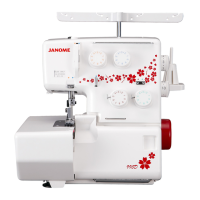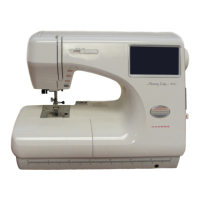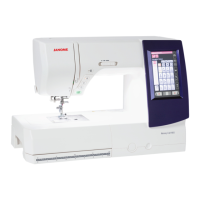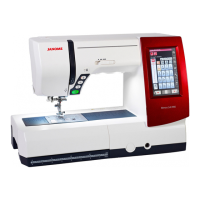Why is the fabric not being fed smoothly through my Janome 9200D Sewing Machine?
- LlorozcoAug 7, 2025
The fabric may not feed smoothly if the feed dog is packed with lint, the presser foot has been raised, or the pressure of the foot is too weak.
Why is the fabric not being fed smoothly through my Janome 9200D Sewing Machine?
The fabric may not feed smoothly if the feed dog is packed with lint, the presser foot has been raised, or the pressure of the foot is too weak.
Why is the thread breaking on my Janome 9200D Sewing Machine?
The thread may be breaking due to several reasons: * The machine might not be threaded correctly. * The needle or looper thread tension could be too tight. * The needle might be incorrectly inserted, bent, or blunt.
Why is my Janome 9200D Sewing Machine seam not sewn neatly?
A seam that is not sewn neatly can be caused by several factors: * The needle and/or looper thread tensions are not correctly adjusted. * The machine is not correctly threaded. * The needle and/or the thread are not suitable for the fabric being sewn. * The thread is not between the tension discs.
Why is my Janome 9200D seam puckering?
Seam puckering can occur if the needle or looper thread tension is too tight, the machine is not correctly threaded, or the differential feed dial is not correctly adjusted.
Instructions and warnings related to electrical hazards, including unattended use, wet conditions, and proper unplugging.
General safety guidelines for operation, maintenance, and use by children, covering hazards like burns, fire, and injury.
Identifies and labels all external components and controls of the sewing machine for user reference.
Lists the essential accessories included with the sewing machine for basic operation and maintenance.
Step-by-step guide on how to safely connect the sewing machine to an electrical power source.
Explains how to adjust and control the machine's sewing speed using the foot controller.
Provides crucial safety precautions to follow during machine operation, maintenance, and unattended periods.
Instructions on the correct direction and method for manually turning the sewing machine's handwheel.
Details on how to open and close the machine's side cover for access to internal components.
Instructions on how to open and close the cover for the looper mechanism.
Guidance on correctly positioning the thread guide bar for optimal thread flow during sewing.
Instructions for using spool holder caps and nets, especially for smaller spools, to prevent thread jamming.
Step-by-step procedure for safely removing and inserting needles into the sewing machine.
Explains how to operate the presser foot lifter to raise or lower the presser foot.
Detailed steps for safely detaching the presser foot from the sewing machine.
Instructions for correctly fitting and securing a presser foot onto the sewing machine.
Guidance on adjusting the pressure exerted by the presser foot on the fabric for different material types.
How to adjust the stitch length dial to control the length of stitches produced by the machine.
Instructions on altering the differential feed ratio to manage fabric stretching or gathering.
Procedure for disengaging the upper knife mechanism for sewing without cutting.
Procedure for engaging the upper knife mechanism for cutting fabric during sewing.
How to adjust the cutting width using the dial to match seam allowances or fabric requirements.
Instructions for changing the needle plate setting for standard serging or rolled hemming.
Detailed steps for guiding thread through the lower looper mechanism for proper sewing setup.
Step-by-step guide to thread the upper looper correctly for machine operation.
Instructions for threading the needle on the right side of the machine for sewing.
Procedure for threading the needle on the left side of the machine for sewing.
Guidance on how to begin sewing, including fabric placement and initial thread chain checks.
Instructions on how to properly finish a sewing project, including creating a thread chain.
Method for sewing multiple pieces of fabric consecutively without interruption.
Explanation of how to utilize guide lines on the machine for accurate seam placement.
Illustrates correct thread tension settings for a four-thread overlock stitch and fabric types.
General guidelines for setting and adjusting thread tension dials for optimal stitch balance.
Identifies and provides remedies for situations where the left needle thread tension is too loose.
Identifies and provides remedies for situations where the right needle thread tension is too loose.
Diagnoses and resolves issues with looper thread tension imbalance, specifically when lower is tight and upper is loose.
Diagnoses and resolves issues with looper thread tension imbalance, specifically when upper is tight and lower is loose.
Instructions for threading the machine using only the right needle for three-thread serging.
Instructions for threading the machine using only the left needle for wide three-thread serging.
Illustrates correct thread tension settings for a three-thread overlock stitch and fabric types.
General guidelines for setting and adjusting thread tension dials for optimal stitch balance.
Identifies and provides remedies for situations where the needle thread tension is too loose.
Diagnoses and resolves issues with looper thread tension imbalance, specifically when lower is tight and upper is loose.
Diagnoses and resolves issues with looper thread tension imbalance, specifically when upper is tight and lower is loose.
Illustrates correct thread tension settings for rolled hemming and picot edging techniques.
General guidelines for setting and adjusting thread tension dials for optimal stitch balance.
Identifies and provides remedies for situations where the right needle thread tension is too loose.
Identifies and provides remedies for situations where the upper looper thread tension is too loose.
Diagnoses and resolves issues with looper thread tension imbalance, particularly when upper is tight and lower is loose.
Tips for achieving better results when performing rolled hemming, focusing on thread chain management.
Technique for improving picot edging results by lightly pulling fabric to the back during sewing.
Provides guidance on correct thread tension settings for achieving optimal narrow hemming results.
Recommendations for thread types and fabrics suitable for decorative overedging.
Specifies the necessary machine settings, including needle plate and upper knife position, for decorative overedging.
Recommendations for thread types and fabrics suitable for gathering operations.
Specifies the necessary machine settings, including needle plate and upper knife position, for gathering.
Recommendations for thread types and fabrics suitable for pin tucking techniques.
Specifies the necessary machine settings, including needle plate and upper knife position, for pin tucking.
Instructions for performing pin tucking, including needle removal and guide line usage.
Detailed steps for removing and attaching the upper knife for maintenance or replacement.
Procedure for cleaning the area around the upper knife to remove lint and debris.
Instructions on how to safely remove and replace the sewing machine's light bulb.
Procedure for cleaning the feed dog mechanism to ensure proper fabric feeding.
Guidance on where and how to apply oil to maintain the smooth operation of the sewing machine.
Instructions on the proper method for carrying the sewing machine.
Instructions and warnings related to electrical hazards, including unattended use, wet conditions, and proper unplugging.
General safety guidelines for operation, maintenance, and use by children, covering hazards like burns, fire, and injury.
Identifies and labels all external components and controls of the sewing machine for user reference.
Lists the essential accessories included with the sewing machine for basic operation and maintenance.
Step-by-step guide on how to safely connect the sewing machine to an electrical power source.
Explains how to adjust and control the machine's sewing speed using the foot controller.
Provides crucial safety precautions to follow during machine operation, maintenance, and unattended periods.
Instructions on the correct direction and method for manually turning the sewing machine's handwheel.
Details on how to open and close the machine's side cover for access to internal components.
Instructions on how to open and close the cover for the looper mechanism.
Guidance on correctly positioning the thread guide bar for optimal thread flow during sewing.
Instructions for using spool holder caps and nets, especially for smaller spools, to prevent thread jamming.
Step-by-step procedure for safely removing and inserting needles into the sewing machine.
Explains how to operate the presser foot lifter to raise or lower the presser foot.
Detailed steps for safely detaching the presser foot from the sewing machine.
Instructions for correctly fitting and securing a presser foot onto the sewing machine.
Guidance on adjusting the pressure exerted by the presser foot on the fabric for different material types.
How to adjust the stitch length dial to control the length of stitches produced by the machine.
Instructions on altering the differential feed ratio to manage fabric stretching or gathering.
Procedure for disengaging the upper knife mechanism for sewing without cutting.
Procedure for engaging the upper knife mechanism for cutting fabric during sewing.
How to adjust the cutting width using the dial to match seam allowances or fabric requirements.
Instructions for changing the needle plate setting for standard serging or rolled hemming.
Detailed steps for guiding thread through the lower looper mechanism for proper sewing setup.
Step-by-step guide to thread the upper looper correctly for machine operation.
Instructions for threading the needle on the right side of the machine for sewing.
Procedure for threading the needle on the left side of the machine for sewing.
Guidance on how to begin sewing, including fabric placement and initial thread chain checks.
Instructions on how to properly finish a sewing project, including creating a thread chain.
Method for sewing multiple pieces of fabric consecutively without interruption.
Explanation of how to utilize guide lines on the machine for accurate seam placement.
Illustrates correct thread tension settings for a four-thread overlock stitch and fabric types.
General guidelines for setting and adjusting thread tension dials for optimal stitch balance.
Identifies and provides remedies for situations where the left needle thread tension is too loose.
Identifies and provides remedies for situations where the right needle thread tension is too loose.
Diagnoses and resolves issues with looper thread tension imbalance, specifically when lower is tight and upper is loose.
Diagnoses and resolves issues with looper thread tension imbalance, specifically when upper is tight and lower is loose.
Instructions for threading the machine using only the right needle for three-thread serging.
Instructions for threading the machine using only the left needle for wide three-thread serging.
Illustrates correct thread tension settings for a three-thread overlock stitch and fabric types.
General guidelines for setting and adjusting thread tension dials for optimal stitch balance.
Identifies and provides remedies for situations where the needle thread tension is too loose.
Diagnoses and resolves issues with looper thread tension imbalance, specifically when lower is tight and upper is loose.
Diagnoses and resolves issues with looper thread tension imbalance, specifically when upper is tight and lower is loose.
Illustrates correct thread tension settings for rolled hemming and picot edging techniques.
General guidelines for setting and adjusting thread tension dials for optimal stitch balance.
Identifies and provides remedies for situations where the right needle thread tension is too loose.
Identifies and provides remedies for situations where the upper looper thread tension is too loose.
Diagnoses and resolves issues with looper thread tension imbalance, particularly when upper is tight and lower is loose.
Tips for achieving better results when performing rolled hemming, focusing on thread chain management.
Technique for improving picot edging results by lightly pulling fabric to the back during sewing.
Provides guidance on correct thread tension settings for achieving optimal narrow hemming results.
Recommendations for thread types and fabrics suitable for decorative overedging.
Specifies the necessary machine settings, including needle plate and upper knife position, for decorative overedging.
Recommendations for thread types and fabrics suitable for gathering operations.
Specifies the necessary machine settings, including needle plate and upper knife position, for gathering.
Recommendations for thread types and fabrics suitable for pin tucking techniques.
Specifies the necessary machine settings, including needle plate and upper knife position, for pin tucking.
Instructions for performing pin tucking, including needle removal and guide line usage.
Detailed steps for removing and attaching the upper knife for maintenance or replacement.
Procedure for cleaning the area around the upper knife to remove lint and debris.
Instructions on how to safely remove and replace the sewing machine's light bulb.
Procedure for cleaning the feed dog mechanism to ensure proper fabric feeding.
Guidance on where and how to apply oil to maintain the smooth operation of the sewing machine.
Instructions on the proper method for carrying the sewing machine.
| Brand | Janome |
|---|---|
| Model | 9200D |
| Category | Sewing Machine |
| Language | English |











